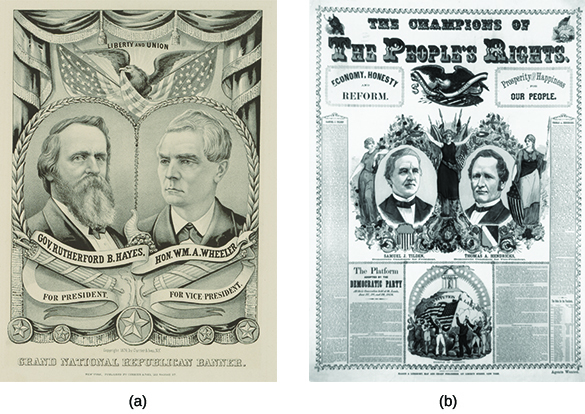| << Chapter < Page | Chapter >> Page > |
Visit the PBS Scrap Book for information on Mark Twain’s life and marriage at the time he wrote The Gilded Age: A Tale of Today .
In many ways, the presidential election of 1876 foreshadowed the politics of the era, in that it resulted in one of the most controversial results in all of presidential history. The country was in the middle of the economic downturn caused by the Panic of 1873, a downturn that would ultimately last until 1879, all but assuring that Republican incumbent Ulysses S. Grant would not be reelected. Instead, the Republican Party nominated a three-time governor from Ohio, Rutherford B. Hayes. Hayes was a popular candidate who advocated for both “hard money”—an economy based upon gold currency transactions—to protect against inflationary pressures and civil service reform, that is, recruitment based upon merit and qualifications, which was to replace the practice of handing out government jobs as “spoils.” Most importantly, he had no significant political scandals in his past, unlike his predecessor Grant, who suffered through the Crédit Mobilier of America scandal . In this most notorious example of Gilded Age corruption, several congressmen accepted cash and stock bribes in return for appropriating inflated federal funds for the construction of the transcontinental railroad.
The Democrats likewise sought a candidate who could champion reform against growing political corruption. They found their man in Samuel J. Tilden, governor of New York and a self-made millionaire, who had made a successful political career fighting corruption in New York City, including spearheading the prosecution against Tammany Hall Boss William Tweed, who was later jailed. Both parties tapped into the popular mood of the day, each claiming to champion reform and promising an end to the corruption that had become rampant in Washington ( [link] ). Likewise, both parties promised an end to post-Civil War Reconstruction.

The campaign was a typical one for the era: Democrats shone a spotlight on earlier Republican scandals, such as the Crédit Mobilier affair, and Republicans relied upon the bloody shirt campaign , reminding the nation of the terrible human toll of the war against southern confederates who now reappeared in national politics under the mantle of the Democratic Party. President Grant previously had great success with the “bloody shirt” strategy in the 1868 election, when Republican supporters attacked Democratic candidate Horatio Seymour for his sympathy with New York City draft rioters during the war. In 1876, true to the campaign style of the day, neither Tilden nor Hayes actively campaigned for office, instead relying upon supporters and other groups to promote their causes.

Notification Switch
Would you like to follow the 'U.s. history' conversation and receive update notifications?